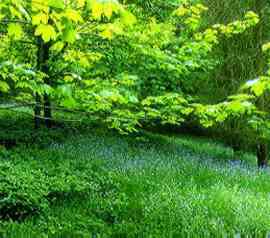Britain in the Past
 Our countryside today is almost all artificially made. Wolves, bears, lynx, reindeer, moose, beavers and wild boar used to roam much of Britain before humans took control of most of the land. Changes in climate have also impacted habitats - in Europe, over 100,000 years ago there were also elephants, lions and hyenas!
Our countryside today is almost all artificially made. Wolves, bears, lynx, reindeer, moose, beavers and wild boar used to roam much of Britain before humans took control of most of the land. Changes in climate have also impacted habitats - in Europe, over 100,000 years ago there were also elephants, lions and hyenas!
For about 7000 years, following the end of the last Ice Age, nearly the whole of Britain was covered with forest mostly consisting of broad-leaved trees, oak and elm being the most common species. These trees and woodlands provided habitats for many more animals then can be found here today - many of them have now become extinct in this country.
About 5,000 years ago, the Neolithic people in Britain began to clear the forests for cultivation and permanent settlements. These people used flint axes for cutting down trees which they used for fuel and the land was cultivated.
In 500 BC the Celts arrived with their more advanced technologies began to create fields for crops and meadows for cattle. The Celts and Romans mainly concentrated on cultivating light soils, chalk and limestones, on higher ground and they put sheep and cattle on these downlands preventing them from reverting to woodland.
 The Anglo-Saxons, using eight-ox ploughs to turn heavy clay soil, cleared many valleys and much of the farmland of the high ground was abandoned. Beech woodland took over in many places but elsewhere sheep continued to graze, keeping the land clear of trees. This is how the chalk and limestone grasslands were formed. Today they are considered a disappearing habitat, home to several endangered species of flowers.
The Anglo-Saxons, using eight-ox ploughs to turn heavy clay soil, cleared many valleys and much of the farmland of the high ground was abandoned. Beech woodland took over in many places but elsewhere sheep continued to graze, keeping the land clear of trees. This is how the chalk and limestone grasslands were formed. Today they are considered a disappearing habitat, home to several endangered species of flowers.
Most of the remaining forest disappeared during the 16th and 17th centuries to provide timber for boats or charcoal for the iron industry. During this century, even more of our woodlands have been cleared and very few of the scattered woodlands date back to prehistoric times. Most have been replanted at some stage and are poorly managed. Some of the most successful broad-leaved woodlands today are those managed by private estates and pheasant reserves. Another type of ancient British woodland can be found in the highlands of Scotland – the Caledonian pine forests, made up mainly of coniferous Scots Pine Trees.
Today there is a growing movement for 'rewilding'. That is, leaving habitats to develop naturally - without human management, control or intervention. Rewilding also calls for the reintroduction of species that were hunted or pushed to the side and made extinct. In some areas in Britain rewilding projects are taking place that look at the benefits or reintroducing wild boar and beavers.
Read More: Artificially Created Habitats